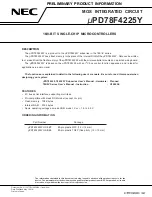UM10850
All information provided in this document is subject to legal disclaimers.
© NXP B.V. 2016. All rights reserved.
User manual
Rev. 2.4 — 13 September 2016
384 of 464
NXP Semiconductors
UM10850
Chapter 25: LPC5410x 12-bit ADC controller (ADC0)
25.6.11 ADC Startup register
This register is used exclusively when enabling the ADC, and typically only by the ADC
API. This register should never be accessed during normal ADC operation. The ADC
clock should be selected and running at full frequency prior to writing to this register.
25.6.12 ADC Calibration register
This register is used to perform ADC offset calibration. It will be used by the ADC API. It
may also be written-to subsequently by user software to initiate re-calibration.
The
maximum ADC clock frequency during calibration is 30 MHz
. If the operating ADC
frequency exceeds this, a slower clock should be selected for calibration (eg. increasing
the synchronous divided clock value).
Table 430: ADC Startup register (STARTUP, address offset 0x6C) bit description
Bit
Symbol
Description
Reset
value
0
ADC_ENA
ADC Enable bit. This bit can only be set to a 1 by software. It is cleared automatically whenever
the ADC is powered down.
This bit must not be set until at least 10 microseconds after the ADC is powered up (typically by
altering a system-level ADC power control bit).
0
1
ADC_INIT
ADC Initialization. After enabling the ADC (setting the ADC_ENA bit), the API routine will
EITHER set this bit or the CALIB bit in the CALIB register, depending on whether or not
calibration is required.
Setting this bit will launch the “dummy” conversion cycle that is required if a calibration is not
performed. It will also reload the stored calibration value from a previous calibration unless the
BYPASSCAL bit is set.
This bit should only be set AFTER the ADC_ENA bit is set and after the CALIREQD bit is tested
to determine whether a calibration or an ADC dummy conversion cycle is required. It should not
be set during the same write that sets the ADC_ENA bit.
This bit can only be set to a ‘1’ by software. It is cleared automatically when the “dummy”
conversion cycle completes.
0
31:2
-
Reserved. Read value is undefined, only zero should be written.
0
Table 431: ADC Calibration register (CALIB, address offset 0x70) bit description
Bit
Symbol
Description
Reset
value
0
CALIB
Calibration request. Setting this bit will launch an ADC calibration cycle.
This bit can only be set to a ‘1’ by software. It is cleared automatically when the calibration
cycle completes.
0
1
CALREQD
Calibration required. This read-only bit indicates if calibration is required when enabling the
ADC. CALREQD will be ‘1’ if no calibration has been run since the chip was powered-up and if
the BYPASSCAL bit in the CTRL register is low.
The ADC API will test this bit to determine whether to initiate a calibration cycle or whether to
set the ADC_INIT bit (in the STARTUP register) to launch the ADC initialization process which
includes a “dummy” conversion cycle. Note: A “dummy” conversion cycle requires
approximately 6 ADC clocks as opposed to 81 clocks required for calibration.
1
8:2
CALVALUE
Calibration Value. This read-only field displays the calibration value established during last
calibration cycle. This value is not typically of any use to the user.
0
31:9
-
Reserved. Read value is undefined, only zero should be written.
0


















